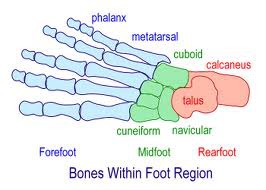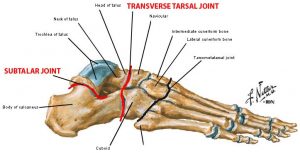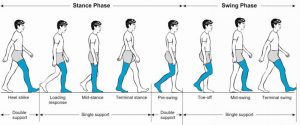Pronation and Supination
The foot is composed of 26 bones and 33 joints, so its movement is very complicated. This complexity is very necessary, otherwise, we cannot adapt to different types of ground, cannot bear the weight of several times our body weight, and cannot efficiently store and release energy during exercise.
However, because of this complexity, the movement of the foot and ankle is often confusing, and many people can’t even distinguish the movement of the foot from the ankle.
This article will talk about the three-dimensional movement of the foot.
1. What are pronation and supination?
The bones of the foot are divided into three parts, the forefoot, the midfoot, and the hindfoot.


The forefoot is composed of metatarsals and phalanges, including 19 bones; the midfoot is composed of five bones, namely the navicular bone, cuboid bone, and three cuneiform bones; the hindfoot contains the talus and calcaneus.
The 7 bones of the hind foot and midfoot are collectively called the tarsal bones.
The tarsal bone is very important for the movement of the foot and involves two main joints: the subtalar joint and the transverse tarsal joint.

The two red lines in the figure above represent the subtalar joint and the transverse tarsal joint respectively.
These two joints can perform the three-dimensional movement, which is the basis of the three-dimensional movement of the foot.
The combination of the movement of the tarsal bone and the ankle joint constitutes the six basic movements of the foot and ankle.

In daily life and sports, the ankles rarely move in only one direction but combine multiple directions. This forms two combined movement modes, which we call pronation and supination.
Among them, pronation refers to the combination of dorsiflexion, valgus, and abduction; supination refers to plantar flexion, inversion, and adduction.
A more common confusion is to equate pronation and supination with valgus and varus. Pronation and valgus are movements in one direction, while pronation and supination are three-dimensional.
In the standing and turning movements, we can experience the different movements of the feet on both sides, one side is pronated and the other side is supinated.
Stand naturally with your toes facing forward and palms of your hands pointing forward. Then try to turn to the right, with small movements, keeping your feet still.
Experience the different movements of the feet on both sides. At this time, the left foot is pronation and the right foot is supination.
When turning to the left, the right foot is pronation and the left foot is supination.
2. Pronation and supination in gait
Human walking is a task that requires advanced coordination capabilities to be achieved, involving a series of events occurring in a certain order. For the ankle, pronation, and supination alternately when walking. Although the gait is highly personalized, the normal gait includes the following eight stages.

The eight stages from left to right are initial landing (bilateral support), load-bearing response period, mid-support phase, end-support phase, early swing (bilateral support), early swing phase, mid-swing phase, and end swing phase.
From the initial landing, the lower limbs on the front side perform a pronation motion.
It starts with the outside of the heel landing on the ground and then passes forward and upward. Passing forward makes the hindfoot, midfoot, and forefoot pronation in sequence, and passing upward makes the legs, hip joints, pelvis, and spine rotate in sequence.
The supination starts from the middle of the support phase, and the lower limbs are supinated in sequence.
The heel is raised, the ankle is plantarflexed, and the calcaneus is turned inward.
When landing, the foot is pronated and the tarsal bone is relatively relaxed, which is beneficial to absorb shocks and store elasticity in the connective tissue. When the heel is raised inWhen the heel is raised in the middle of the supporting phase, the tarsal bone locks and stores the energy in the connective tissue. Is released, pushing the body forward more efficiently.
This mechanism is an important reason why human walking is efficient.
The mid-support phase is the key position for the foot to transform from pronation to supination. In Nicholas Romanov’s posture running method, this position is regarded as the key running position. The analysis of the body posture in this position can provide us with a lot of useful information.
3. Excessive pronation and insufficient pronation
Appropriate pronation and supination are necessary, but if they exceed the proper range, it will cause some problems.
Pronation deformity syndrome is a phenomenon of lower limb postural compensation that we often mention. It refers to excessive pronation of the lower limbs.
The picture above shows excessive pronation in a typical stance.
In the posterior view, the valgus and abduction (external rotation of the foot relative to the calf) of the hindfoot can be seen. If excessive pronation is also present in the midfoot area, it will reduce the arch height, resulting in flat feet.
Excessive pronation is manifested in gait as valgus and calcaneus valgus.
People with excessive pronation cannot support the arch of the foot in the middle of the support phase during walking and running, resulting in insufficient stability of the hind foot, which not only fails to store and release energy efficiently but also easily leads to injury.
Insufficient pronation is relatively rare. It is the opposite of excessive pronation. During the entire gait cycle, it is in a locked state and cannot make full use of the elasticity of the connective tissue to absorb the impact. These instantaneous loads are directly applied to the joints, which increases joint damage. The odds. At the same time, in the case of insufficient pronation, energy cannot be stored and released effectively, and muscles need to be repeatedly used to break and advance, which increases muscle fatigue and tension.
The picture above shows the running posture under the condition of insufficient pronation, and the arch of the foot always maintains a high height.
From the anatomical structure, we can see why excessive pronation is more likely to occur than insufficient pronation.
The medial longitudinal arch of the foot is much higher than the lateral longitudinal arch, which makes the structure of the foot a bit like a wedge, and it is easier to fall to the inside, that is, valgus and pronation occur.
Relative post:
https://aideastep.com/pronation-and-supination-of-the-foot/
https://aideastep.com/insole-to-correct-pronation/
Hot blogs:
The Easiest Custom Insoles: Heat Moldable Insoles
Custom insoles, also known as orthotic insoles, are designed to provide personalized support and comfort for individuals with various foot conditions. In [...]
Children’s Insole Size Conversion Chart
The standard sizes for shoe insoles may vary from country to country, making it a headache to choose the right insole for [...]
Do custom orthotics need to be made by a doctor personally?
Custom orthotics do not necessarily need to be made by a doctor personally. While doctors, specifically podiatrists or orthopedic specialists, are often [...]
Do NBA players use custom insoles?
Custom insoles are not only helpful for people with foot health issues, but they also play a significant role in targeting the [...]
